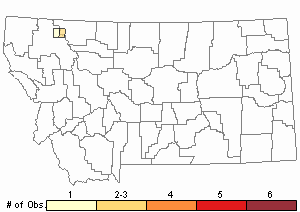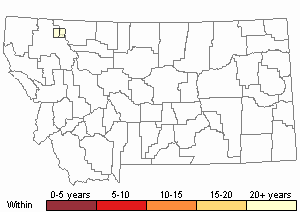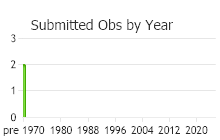View in other NatureServe Network Field Guides
NatureServe
Montana
Utah
Wyoming
Idaho
Wisconsin
British Columbia
South Carolina
Yukon
California
New York
A Sarmenthypnum Moss - Sarmentypnum sarmentosum
Other Names:
Calliergon sarmentosum
General Description
Plants: Pleurocarpous (Vitt 1988), in scattered or gregarious mats or tufts, most often red, turning purple or brownish-black with age, occasionally green, smudged with purple or red. Stems 6-12 cm or more in length, simple or branched (Lawton 1971); possessing a central strand (FNA 2014).
Leaves: Stem leaves compact and overlapping, or further apart and upright-spreading, 1.5-3 mm in length, 0.5-1 mm in width, contorted and faintly folded longitudinally when dry (Lawton 1971), slightly concave, ovate to narrowly so or tending to oblong, with a sudden narrowing to the apex, the apex curved or short-apiculate (FNA 2014); branch leaves resembling stem leaves; margins smooth, rolled inwards or occasionally flat; costa robust (Lawton 1971), extending 4/5 to almost entire leaf length (FNA 2014).
Leaf Cells: Laminal cells porose; median and apical cells thick-walled, the apical cells shorter; basal cells frequently red to violet or yellow; alar region a distinct group of inflated cells (Lawton 1971) that become more thickly-walled closer to the costa (Lawton 1971); upper cells of axillary hairs usually 1-4 in number (FNA 2014).
Diagnostic Characteristics
Species of Calliergon, which are similar to S. sarmentosum, have wider leaves and never display a rich red color. Straminergon straminium does not form an apiculus, nor is it ever red (FNA 2014).
The apiculus of S. sarmentosum is often partially worn away in older leaves (FNA 2014).
Range Comments
In North America: From AK e to NU and BC e to NL, WA, MT s to CO, NY and NH. Also found in Greenland, South America, Eurasia, e Africa, Pacific Islands, Australia, and Antarctica (FNA 2014). Known in Montana from Glacier County (Elliott 2016).
Observations in Montana Natural Heritage Program Database
Number of Observations: 4
(Click on the following maps and charts to see full sized version)
Map Help and Descriptions
Relative Density

Recency



 (Observations spanning multiple months or years are excluded from time charts)
(Observations spanning multiple months or years are excluded from time charts)
Habitat
Soil and humus in fens and springs (Elliott 2016), and underwater in lakes. Elevation 0-13,125 feet (FNA 2014).
Reproductive Characteristics
Dioicous. Seta 20-25 mm in length. Capsule theca 1.5-2.5 mm in length (Lawton 1971).
Stewardship Responsibility
References
- Literature Cited AboveLegend:
 View Online Publication
View Online Publication Elliott, J.C. and A.K. Pipp. 2018. A Checklist of Montana Mosses (1880-2018). Updated 3 January, 2020. Montana Natural Heritage Program, Helena, Montana. 73 pp.
Elliott, J.C. and A.K. Pipp. 2018. A Checklist of Montana Mosses (1880-2018). Updated 3 January, 2020. Montana Natural Heritage Program, Helena, Montana. 73 pp. Flora of North America Editorial Committee, eds. 2014. Flora of North America North of Mexico. Volume 28. Bryophytes: Mosses, Part 2. Oxford University Press, Inc., NY. xxi + 702 pp.
Flora of North America Editorial Committee, eds. 2014. Flora of North America North of Mexico. Volume 28. Bryophytes: Mosses, Part 2. Oxford University Press, Inc., NY. xxi + 702 pp. Lawton, E. 1971. Moss Flora of the Pacific Northwest. Hattori Botanical Laboratory. Japan: Yamabuki-cho, Shinjuku-ku, Tokyo. 362 pages plus appendices.
Lawton, E. 1971. Moss Flora of the Pacific Northwest. Hattori Botanical Laboratory. Japan: Yamabuki-cho, Shinjuku-ku, Tokyo. 362 pages plus appendices. Vitt, D. J. Marsh, and R. Bovey. 1988. Mosses, Lichens & Ferns of Northwest North America. Seattle, WA: University of Washington Press. 296 p.
Vitt, D. J. Marsh, and R. Bovey. 1988. Mosses, Lichens & Ferns of Northwest North America. Seattle, WA: University of Washington Press. 296 p.
- Additional ReferencesLegend:
 View Online Publication
View Online Publication
Do you know of a citation we're missing? Elliot, J. C. 1993. Second checklist of Montana mosses. Unpublished report. U.S. Forest Service, Region 1. Missoula, MT. 45 pp.
Elliot, J. C. 1993. Second checklist of Montana mosses. Unpublished report. U.S. Forest Service, Region 1. Missoula, MT. 45 pp. Lawton, E. 1971. Keys for the Identification of the Mosses on the Pacific Northwest. Reprinted from 'Moss Flora of the Pacific Northwest'. Published as Supplement No. 2 of the Journal of the Hattori Botanical Laboratory. Nichinan, Miyazaki, Japan. 66 pp.
Lawton, E. 1971. Keys for the Identification of the Mosses on the Pacific Northwest. Reprinted from 'Moss Flora of the Pacific Northwest'. Published as Supplement No. 2 of the Journal of the Hattori Botanical Laboratory. Nichinan, Miyazaki, Japan. 66 pp.
- Web Search Engines for Articles on "A Sarmenthypnum Moss"





